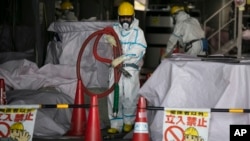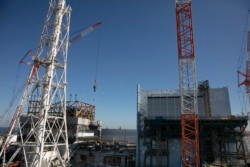The Japanese government, citizens and groups are debating what to do with radioactive water from the disabled nuclear power center near Fukushima.
An earthquake and tsunami on March 11, 2011 caused severe damage to three of the six nuclear reactors at the Fukushima Daiichi Nuclear Power Plant. Since then, Japanese officials have been struggling to contain and clean up the damage.
The Associated Press recently observed the decontamination process taking place there. Officials are trying to decide what to do with 1.2 million tons of radioactive water being stored at Fukushima.
The nuclear center is operated by the Tokyo Electric Power Co., or TEPCO. The company says it needs to free up space as work on the damaged reactors reaches an important point.
Many people expect TEPCO to slowly release the water into the ocean near the nuclear centers. The government has already approved the plan. However, it is not clear when the company will carry out the plan.
Local people oppose it because releasing the water into the nearby sea could hurt fisheries. Sales of fish caught off the coast near Fukushima are 50 percent of what they were before the nuclear disaster. Fish caught in the area have been approved for sale after radioactivity testing by health officials.
TEPCO Chief Decommissioning Officer Akira Ono said the water must be removed. He says crews need the space currently occupied by the water tanks. In their place, workers will set up structures to hold melted reactor wreckage.
Workers are planning to remove wreckage of the melted reactor by December 2021. Special equipment is taking apart Unit 2. Radioactive waste is being removed from Unit 3. People wear protective clothing and head coverings to work in all but the most radioactive areas around the nuclear center.
But underground, conditions remain dangerous and radioactive water is leaking from the melted reactors and mixing with groundwater. This water is being pumped into containers to keep it from flowing into the sea.
The contaminated water from underground is processed and filtered to remove dangerous radioactive elements. Tritium is the only radioactive material that remains. Japan’s industry ministry and nuclear officials say tritium is not harmful in small amounts.
However, although officials try to ease public fear, there are worries that fish might be affected if the water is released into the sea.
Katsumi Shozugawa is a radiology expert at the University of Tokyo. He has been studying the underground water around the nuclear center. He said long-term results of low-level exposure to radioactivity in the food chain has not been fully studied.
“At this point it is difficult to predict risk,” he said. “Once the water is released into the environment, it will be very difficult to follow up and monitor its movement.”
After years of discussions, a government group released a report earlier this year. It proposed two possible ways to dispose of the treated water. One method would mix treated water with fresh water and release it into the ocean. A second method would permit the water to dry up over time.
The report also urged the government to do more to fight the “reputational damage” done to Fukushima’s fishing and farming products.
TEPCO and government officials have said they will treat the water a second time to meet legal requirements before any release.
Masumi Kowata lives in Okuma, a town close to the nuclear center. She said some of her neighbors are offering their land as a place to put more water storage tanks.
“We should not dump the water until we have proof about its safety,” she said. “The government says it’s safe, but how do we know?”
I’m Mario Ritter Jr.
Mari Yamaguchi reported this story for the Associated Press. Mario Ritter Jr. adapted it for VOA Learning English. Caty Weaver was the editor.
__________________________________________________________
Words in This Story
decontamination –n. the process of removing contamination, substances that are dangerous or radioactive
filter –v. to pass (something, such as a gas or liquid) through a filter to remove something unwanted
monitor to watch or observe over a period of time
dispose of –v. to take something away, remove from a place
reputational –adj. related to someone’s reputation, to the common opinion of others about someone or something










